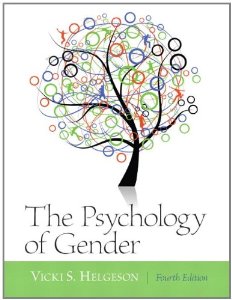Instant download Test Bank for Psychology of Gender, 4th Edition: Helgeson pdf docx epub after payment.

Product details:
- ISBN-10 : 0205050182
- ISBN-13 : 978-0205050185
- Author: Vicki S. Helgeson
Unlike other gender texts, Psychology of Gender focuses equally on both men and women, drawing from empirical research and conceptual discussions.The book includes research and discussions surrounding gender in the areas of psychology, sociology, anthropology, medicine, and public health. It reviews the research from multiple perspectives, but emphasizes the implications of social roles, status, and gender-related traits, particularly for relationships and health–areas that are central to students’ lives and that have a great impact on their day-to-day functioning. The text is designed for upper-level undergraduate/graduate-level gender-focused courses in a variety of departments.
Table of contents:
IN THIS SECTION:
1.) BRIEF
2.) COMPREHENSIVE BRIEF
TABLE OF CONTENTS:
Chapter 1: Introduction
Chapter 2: Methods and History of Gender Research
Chapter 3: Gender-Role Attitudes
Chapter 4: Sex-Related Comparisons: Observations
Chapter 5: Sex-Related Comparisons: Theory
Chapter 6: Achievement
Chapter 7: Communication
Chapter 8: Friendship
Chapter 9: Romantic Relationships
Chapter 10: Sex Differences in Health: Evidence and Explanations
Chapter 11: Relationships and Health
Chapter 12: Paid Worker Role and Health
Chapter 13: Mental Health
COMPREHENSIVE
TABLE OF CONTENTS:
Chapter 1: Introduction Definition of Terms Cultural Differences in the Construal of Gender Cultures with Multiple Genders Morocco The Agta Negrito Tahiti Status and Culture Philosophical and Political Issues Surrounding Gender The Sex Difference Debate Social Construction of Gender Women’s Movements Men’s Movements A Note On Sexist Language This Book’s Approach to the Study of Gender Summary Discussion Questions Suggested Reading Key Terms
Chapter 2: Methods and History of Gender Research The Scientific Method Correlational Study Experimental Study Field Experiment Cross-Sectional Versus Longitudinal Designs Difficulties in Conducting Research on Gender Experimenter Effects Participant Effects The Setting: Laboratory Versus Field Variables Confounded with Sex Situational Influences History of the Psychology of Gender 1894–1936: Sex Differences in Intelligence 1936–1954: M/F as a Global Personality Trait 1954–1982: Sex Typing and Androgyny 1982–Present: Gender as a Social Category Summary Discussion Questions Suggested Reading Key Terms
Chapter 3: Gender-Role Attitudes Attitudes Toward Men’s and Women’s Roles Affective Component: Sexism Traditional Versus Modern Sexism Hostile Versus Benevolent Sexism Sexism Toward Men Attitudes toward Lesbians, Gay, Bisexual, and Transgendered (LGBT) Persons Cognitive Component: Gender-Role Stereotyping What Is a Gender-Role Stereotype? Components of Gender-Role Stereotypes Gender-role Stereotypes of Older People Gender-role Stereotypes of People Who Vary in Ethnicity or Culture Stereotypes of Homosexuals Children’s Stereotypes Subcategories of Gender-Role Stereotypes Effects of Gender-Role Stereotypes Altering Gender-Role Stereotypes Do Stereotypes Reflect Reality? What Is the Status of Stereotypes Today? Behavioral Component: Sex Discrimination Summary Discussion Questions Suggested Reading Key Terms
Chapter 4: Sex-Related Comparisons: Observations Maccoby and Jacklin’s Psychology of Sex Differences Meta-Analysis Sex Comparisons in Cognitive Abilities Spatial Ability Mathematical Ability Verbal Ability Comprehensive Assessment of Cognitive Abilities Sex Comparisons in Social Domains Empathy Helping Behavior Aggression Sexuality General Personality Attributes Sex Comparisons in Moral Development Sex Comparisons in Social Development Sex Similarities Hypothesis Revisited Summary Discussion Questions Suggested Reading Key Terms
Chapter 5: Sex-Related Comparisons: Theory Biology Genes Hormones The Brain Psychobiosocial Models Evolutionary Theory and Sociobiology Sexual Behavior Aggression The Hunter-Gatherer Society A Final Note Psychoanalytic Theory Social Learning Theory Observational Learning or Modeling Reinforcement Gender-Role Socialization The Influence of Parents The Influence of Other People Other Features of the Environment Social Role Theory Cognitive Development Theory Gender Schema Theory Considering the Context: Deaux and Major’s Model Perceiver Target Situation Summary Discussion Questions Suggested Reading Key Terms
Chapter 6: Achievement Individual Difference Factors The Achievement Motive Fear of Achievement Self-Confidence Response to Evaluative Feedback Self-Esteem Stereotype Threat Conceptions of the Self Attributions for Performance Social Factors Expectancy/Value Model of Achievement The Influence of Parents The Influence of Teachers Summary Discussion Questions Suggested Reading Key Terms
Chapter 7: Communication Interaction Styles in Childhood Children’s Styles of Play Girls’ Difficulty in Influencing Boys Institutional Support Interaction Styles in Adulthood Qualifiers of Sex Differences Implications of Interaction Styles for Performance Language Qualifiers of Sex Differences Nonverbal Behavior Smiling Gazing Interpersonal Sensitivity Encoding Touching Leadership and Influenceability Who Is Influenced? Who Emerges as the Leader? Leadership Styles Perception of Female and Male Leaders Emotion The Experience of Emotion The Expression of Emotion Physiological Measures of Emotion Attributions for Emotion Explanations for Sex Differences in Communication Status Theory Social Role Theory Summary Discussion Questions Suggested Reading Key Terms
Chapter 8: Friendship Network Size The Nature of Friendship Sex Differences Sex Similarities Closeness of Friendship Self-Disclosure Sex of Discloser Sex of Recipient Situational Variables Barriers to Closeness in Male Friendship Competition Homophobia Emotional Inexpressiveness Conflict in Friendship Cross-Sex Friendship Comparisons to Same-Sex Friendship Obstacles Cross-Race Friendship Friendships of Lesbians and Gay Men Friendship at Work Changes Over the Life Span Early Adulthood: Marriage and Family Late Adulthood: Retirement and Empty Nest Summary Discussion Questions Suggested Reading Key Terms
Chapter 9: Romantic Relationships Relationship Development Characteristics Desired in a Mate Relationship Initiation The Nature of Romantic Relationships Intimacy Love Sexuality Maintaining Relationships Maintenance Strategies Relationship Satisfaction Conflict Conflict Management Demand/Withdraw Pattern Jealousy Cohabiting Relationships Who Cohabits Outcomes of Cohabitation Summary Discussion Questions Suggested Reading Key Terms
Chapter 10: Sex Differences in Health: Evidence and Explanations Sex Differences in Mortality Life Span Leading Causes of Death Crime Statistics Sex Differences in Morbidity Explanations for Sex Differences in Health Biology Genes Hormones Immune System Cardiovascular Reactivity Artifacts Socioeconomic Status Physician Bias Health Behaviors Preventive Health Care Smoking Alcohol Drugs Overweight and Obesity Exercise Men’s and Women’s Social Roles Job Characteristics Driving Risky Behavior Concerns with Health Nurturant Roles Gender-Related Traits Symptom Perception Evidence Explanations Illness Behavior Implications for Morbidity Implications for Mortality Conclusions Summary Discussion Questions Suggested Reading Key Terms
Chapter 11: Relationships and Health Effects of Social Support on Health Sex Comparisons Evidence: Relations to Health Effects of Marriage on Health Evidence Explanations Effect of Bereavement on Health Evidence Explanations Effect of Relationship Dissolution on Health Relationship Breakup Explanations Marital Transitions and Health Effect of Marital Quality on Health Evidence Division of Labor Who Does What? What Determines Who Does What? Satisfaction Parenting and Health Effects of the Parent Role on Health Effect of Parenthood on Marriage Intimate Partner Violence Incidence Characteristics of Perpetrator and Victims Theories Rape and Other Forms of Sexual Coercion Definitions Incidence Rape Myths Characteristics of Perpetrator Characteristics of Victim Theories Summary Discussion Questions Suggested Reading Key Terms
Chapter 12: Paid Worker Role and Health Paid Worker Role Women’s Employment Effects on the Family Retirement Combining Paid Labor With Family Roles Effects of the Paid Worker Role on Family Roles Effects of Family Roles on the Paid Worker Role Difficulties in Combining Roles Quality of Paid Worker Role Characteristics of Paid Work Effects on Health Discrimination Pay Disparity Denial of Discrimination Sexual Harassment Definitions Incidence Outcomes of Sexual Harassment Characteristics of Perpetrator Characteristics of Victim Theories Summary Discussion Questions Suggested Reading Key Terms Chapter 13: Mental Health Sex Differences in Depression Methodological Artifacts Clinician Bias Response Bias Different Manifestations of Depression Theories of Depression Biology Learned Helplessness Coping Stressful Life Events The Female Gender Role Caregiving Challenges of Adolescence Gender Intensification Puberty Body Image Adjustment to Chronic Illness Male Gender Role Female Gender Role Eating Disorders Definitions and Prevalence Consequences Etiology Suicide Incidence Attempts The Gender Paradox Factors Associated with Suicide Among Adults Factors Associated with Suicide Among Adolescents Summary Discussion Questions Suggested Reading Key Terms
People also search:
Psychology of Gender
Psychology of Gender Helgeson
Psychology of Gender Helgeson 4th
Psychology of Gender Helgeson 4th Test Bank
Test Bank for Psychology of Gender, 4th Edition: Helgeson Download
the psychology of gender identity inclusivity and diversity
|
psychology gender and identity |





